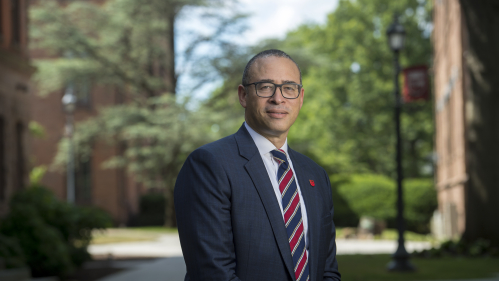President Holloway Starts New Tradition With Budget Address

Commits to growing endowment and investing in areas critical to mission, including research, libraries and athletics
Rutgers’ return to a “normal” financial outlook will be slow following difficult pandemic years, President Jonathan Holloway said in his first budget address to the University Senate Friday as he outlined the priorities reflected, programs supported and some of the challenges that lie ahead.
“As we look at the financial trends like inflation, the changing socio-economic profile of our student applicant pool, political debates about the return on investment of higher education, and state investment in the university, it is clear that we are looking at a multi-year return to normal,” the president said.
Holloway’s talk on finances with the senate was the first of what he plans will be an annual address to bring more clarity to a complex $4.8 billion budget. Planning for the fiscal year 2023 budget, which will be presented to the Rutgers Board of Governors in June, is underway.
“In providing these insights, I hope to enrich the quality of conversations when we discuss the university’s budget,” Holloway said. “I am seeking language that is clear and explanations that are frank and candid as we work to develop coherent plans for the future of Rutgers.”
Noting the university has created a budget website that aims to make it easier to find and understand spending plan information, Holloway highlighted some basic facts that drive annual budget decisions. He also stressed the need to grow the university’s endowment and affirmed support of areas critical to the university’s mission that do not generate profits – from research to athletics.
Budget Basics
One third of the university’s revenues – $1.6 billion – come from tuition, fees and associated federal and state student aid. Patient care services account for 20 percent of the budget and state appropriations and state-paid fringe benefits provide just under 20 percent of annual income.
An important source of revenue at a university is its endowment, Holloway said, noting Rutgers’ is $1.9 billion, significantly lower than peer institutions’ endowments. While one of his top priorities is to help significantly grow the endowment by engaging more alumni and donors to support Rutgers, Holloway noted that endowments are not savings accounts.
“These funds are also often restricted for specific purposes,” he said. “We can only plan on taking, on average, 5 percent of the revenue generated by the endowment to use for our expenses.” Last year, that equaled just over $55 million to defray expenses on a $4.8 billion budget.
Meanwhile, the bulk of the university’s expenses are related to its people – 65 percent of the budget is dedicated to salaries and fringe benefits for employees. “Rutgers is enormous and requires tens of thousands of people to make it run,” Holloway said.
Another 10 percent of the budget goes to scholarships and fellowships, leaving 25 percent of the total for everything else, including care and maintenance of the university’s infrastructure, physical and digital.
Since Rutgers remains committed to being as accessible and affordable as possible for students, the president noted that tuition will not be raised to meet the inflation rate, currently around 7 percent, or to cover the cost of rising salaries, which increased by 5.5 percent in the current fiscal year after delayed increases and salary furloughs for employees during the pandemic.
As the administration looks for new ways to raise revenues, Holloway affirmed a commitment to invest in areas of the university that do not generate profits but are undeniably important to the work of Rutgers – from research to athletics.
“The language of investment here suggests returns to individuals and societies in the form of educated citizens and improved social outcomes, in stronger communities and life-changing research discoveries,” Holloway said. “We invest in the libraries, we invest in the humanities, and, yes, we invest in athletics. In their own ways, each of these areas are important articulations of the health, mission and narrative of the university.”
Holloway said the Rutgers community has been “laboring under the illusion that athletics will generate enough revenue to pay for itself.”
“It won’t,” he said, noting only 2 percent of major college athletics programs run in the black and not many more than that break even. Athletics, which accounts for over 2 percent of the operating budget, helps tell powerful and far-reaching stories about Rutgers through the university’s impressive student-athletes and dedicated coaches, he said.
“What deepens my support for athletics at Rutgers is that we have coaches who are strongly committed to integrity and to seeing their players graduate,” he said. “I take great pride in the fact that we have one of the top-performing athletic programs in the country in terms of academic performance.”
The president thanked the senate members for making painful sacrifices that helped guide the university through the pandemic budget crisis, as he noted more work is ahead.
“My hope is that this talk and the administration's commitment to make the university's financial status less opaque will be seen as an important step in facilitating that work,” Holloway said. As we take the next steps, he added, we “will be able to move forward with a greater sense of purpose, a greater sense of collaboration and a greater sense of confidence that Rutgers can become the very best version of itself in the years ahead.”